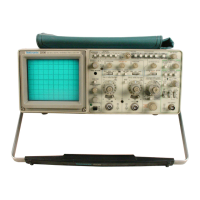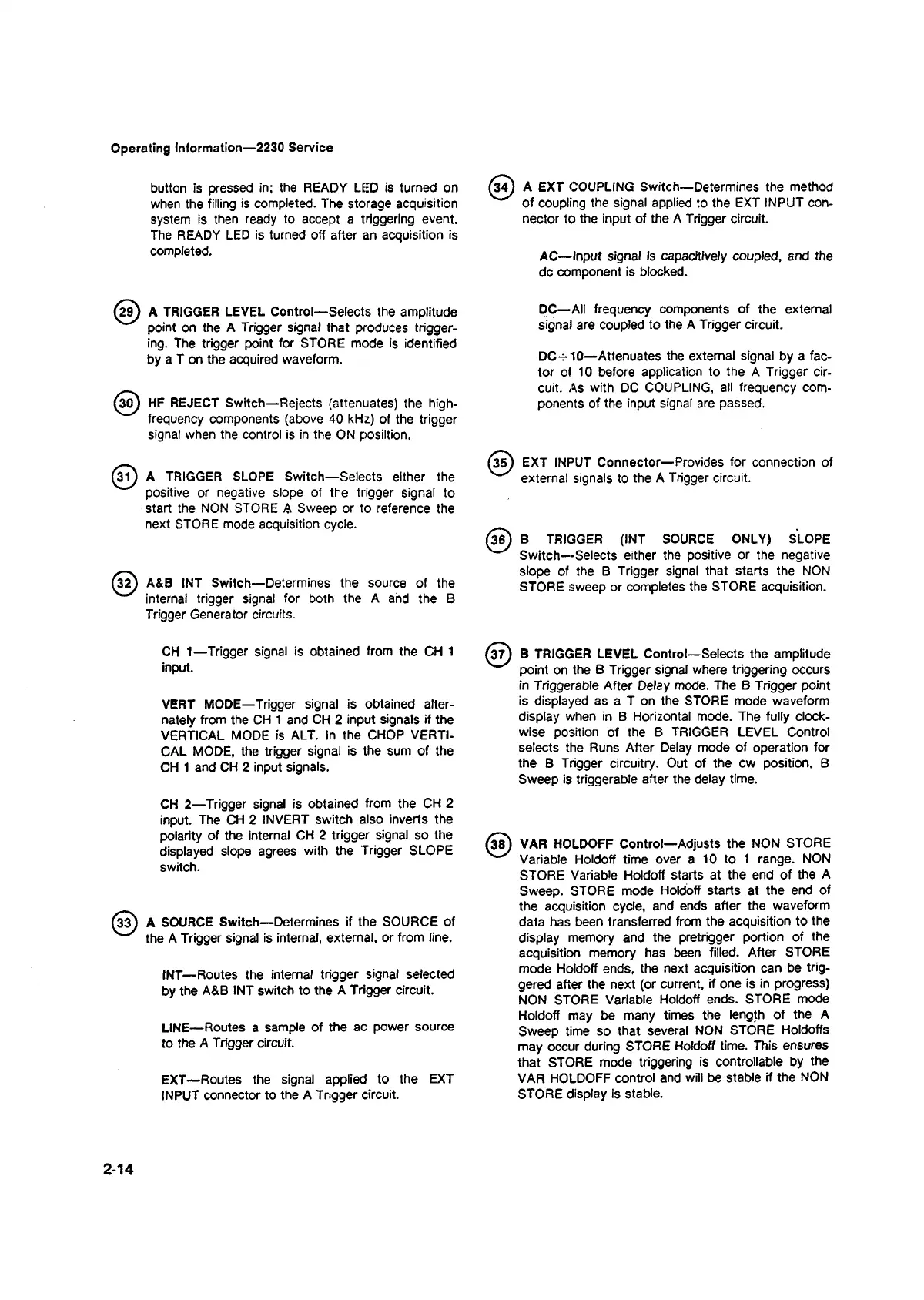Operating Information—2230 Service
button is pressed in; the READY LEED is turned on
when the filling is completed. The storage acquisition
system is then ready to accept a triggering event.
The READY LED is turned off after an acquisition is
completed.
(2 9 ) A TRIGGER LEVEL Control—Selects the amplitude
point on the A Trigger signal that produces trigger
ing. The trigger point for STORE mode is identified
by a T on the acquired waveform.
^ 0 ) HF REJECT Switch—Rejects (attenuates) the high-
frequency components (above 40 kHz) of the trigger
signal when the control is in the ON posiltion.
A TRIGGER SLOPE Switch—Selects either the
positive or negative slope of the trigger signal to
start the NON STORE A Sweep or to reference the
next STORE mode acquisition cycle.
(3^ A&B INT Switch—Determines the source of the
internal trigger signal for both the A and the B
Trigger Generator circuits.
CH 1—Trigger signal is obtained from the CH 1
input.
VERT MODE—Trigger signal is obtained alter
nately from the CH 1 and CH 2 input signals if the
VERTICAL MODE is ALT. In the CHOP VERTI
CAL MODE, the trigger signal is the sum of the
CH 1 and CH 2 input signals.
CH 2—Trigger signal is obtained from the CH 2
input. The CH 2 INVERT switch also inverts the
polarity of the internal CH 2 trigger signal so the
displayed slope agrees with the Trigger SLOPE
switch.
(33 ) A SOURCE Switch—Determines if the SOURCE of
v ' the A Trigger signal is internal, external, or from line.
INT—Routes the internal trigger signal selected
by the A&B INT switch to the A Trigger circuit.
LINE—Routes a sample of the ac power source
to the A Trigger circuit.
EXT—Routes the signal applied to the EXT
INPUT connector to the A Trigger circuit.
(3 4 ) A EXT COUPLING Switch—Determines the method
of coupling the signal applied to the EXT INPUT con
nector to the input of the A Trigger circuit.
AC—Input signal is capacitively coupled, and the
dc component is blocked.
DC—All frequency components of the external
signal are coupled to the A Trigger circuit.
D C -10—Attenuates the external signal by a fac
tor of 10 before application to the A Trigger cir
cuit. As with DC COUPLING, all frequency com
ponents of the input signal are passed.
(35 ) EXT INPUT Connector—Provides for connection of
external signals to the A Trigger circuit.
(36) B TRIGGER (INT SOURCE ONLY) SLOPE
' — Switch-Selects either the positive or the negative
slope of the B Trigger signal that starts the NON
STORE sweep or completes the STORE acquisition.
(37) B TRIGGER LEVEL Control—Selects the amplitude
point on the B Trigger signal where triggering occurs
in Triggerable After Delay mode. The B Trigger point
is displayed as a T on the STORE mode waveform
display when in B Horizontal mode. The fully clock
wise position of the B TRIGGER LEVEL Control
selects the Runs After Delay mode of operation for
the B Trigger circuitry. Out of the cw position, B
Sweep is triggerable after the delay time.
(38) VAR HOLDOFF Control—Adjusts the NON STORE
' —' Variable Holdoff time over a 10 to 1 range. NON
STORE Variable Holdoff starts at the end of the A
Sweep. STORE mode Holdoff starts at the end of
the acquisition cycle, and ends after the waveform
data has been transferred from the acquisition to the
display memory and the pretrigger portion of the
acquisition memory has been filled. After STORE
mode Holdoff ends, the next acquisition can be trig
gered after the next (or current, if one is in progress)
NON STORE Variable Holdoff ends. STORE mode
Holdoff may be many times the length of the A
Sweep time so that several NON STORE Holdoffs
may occur during STORE Holdoff time. This ensures
that STORE mode triggering is controllable by the
VAR HOLDOFF control and will be stable if the NON
STORE display is stable.
2-14

